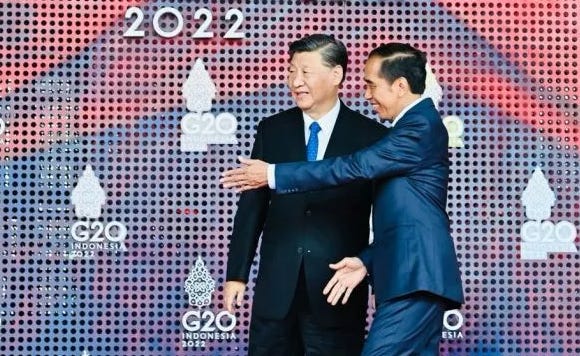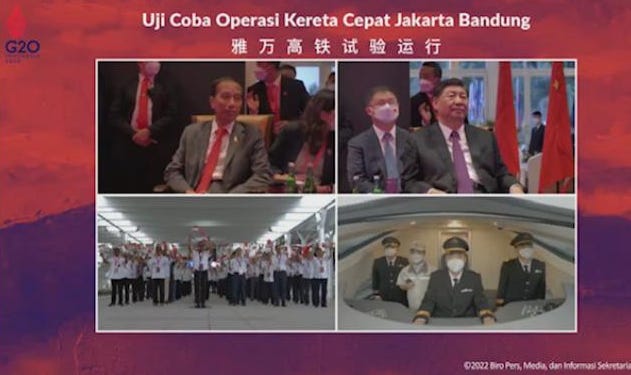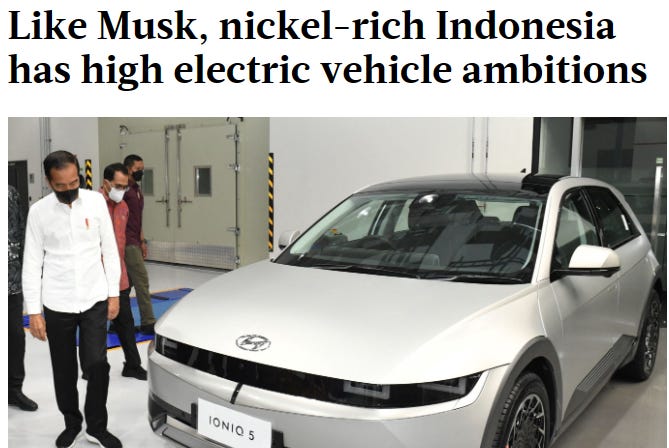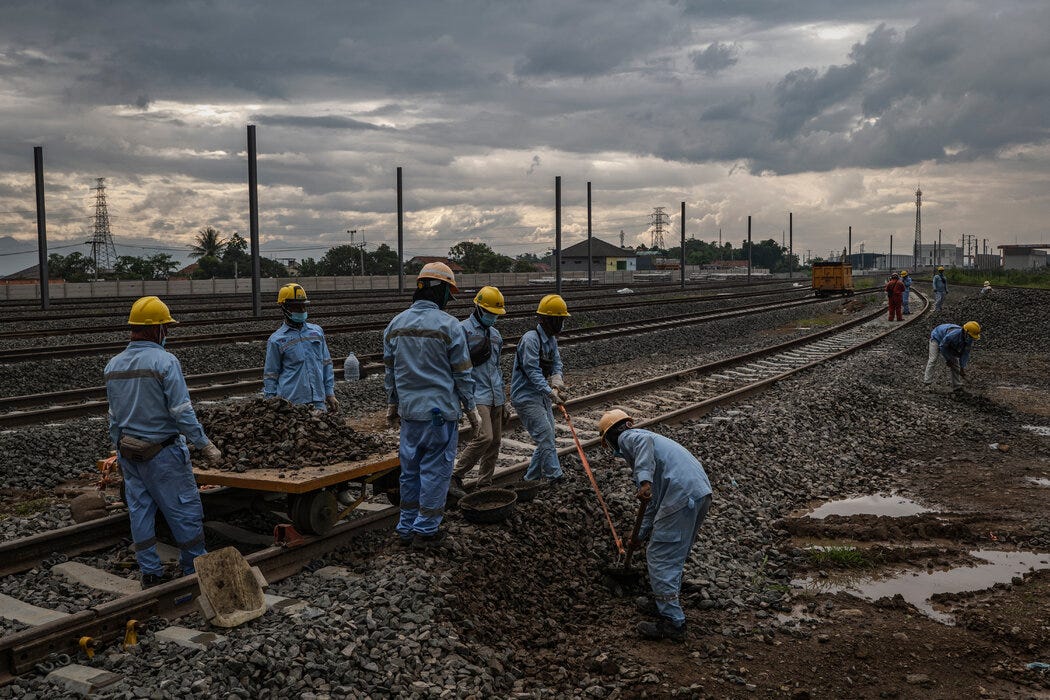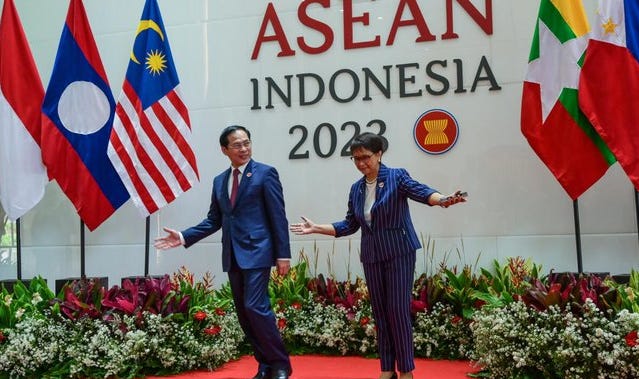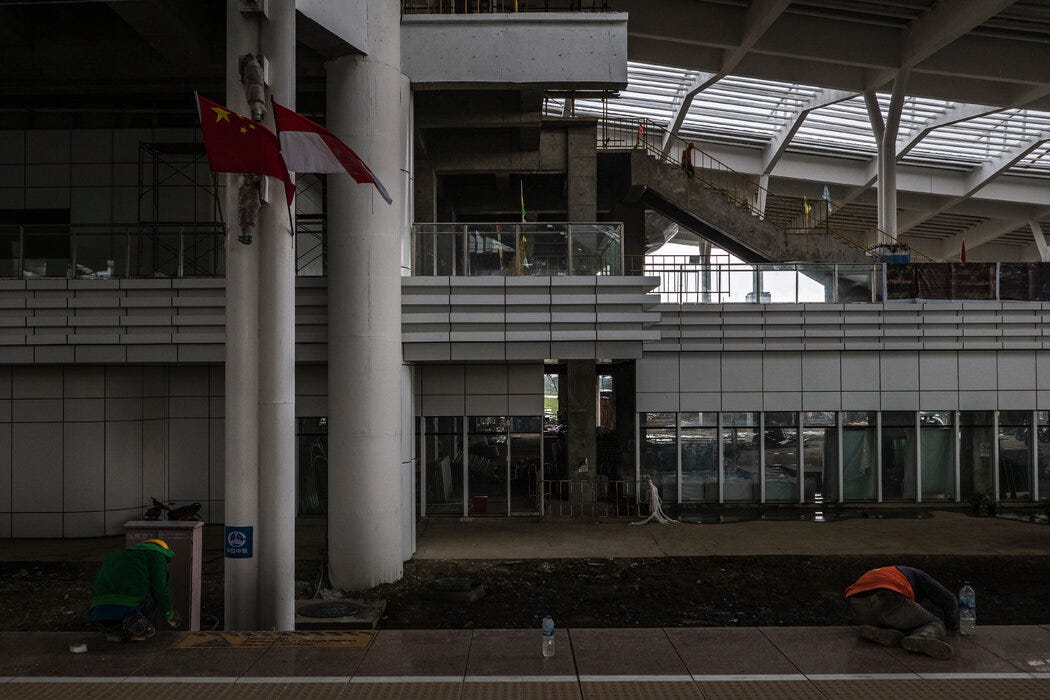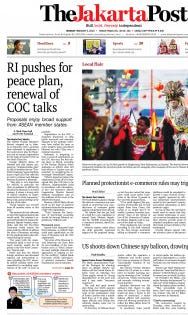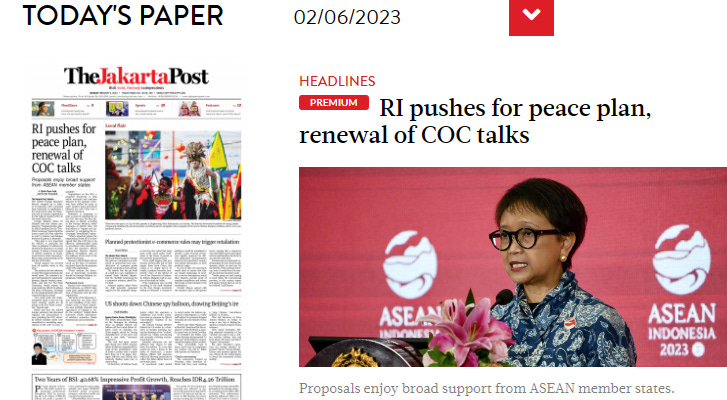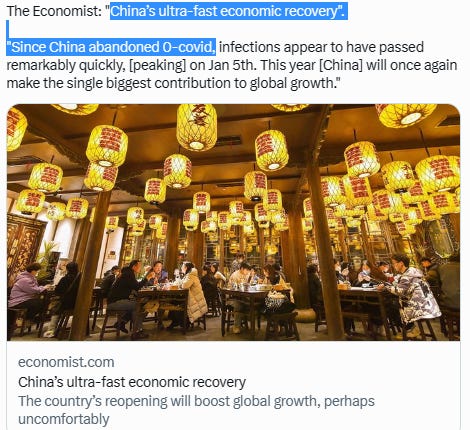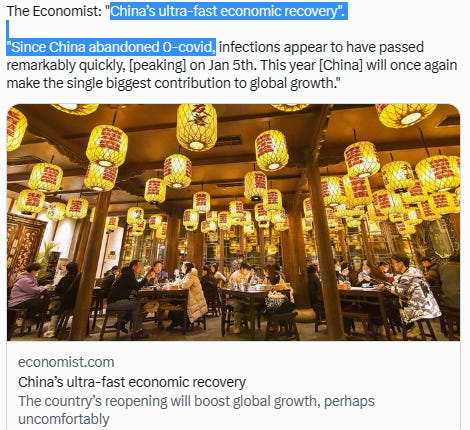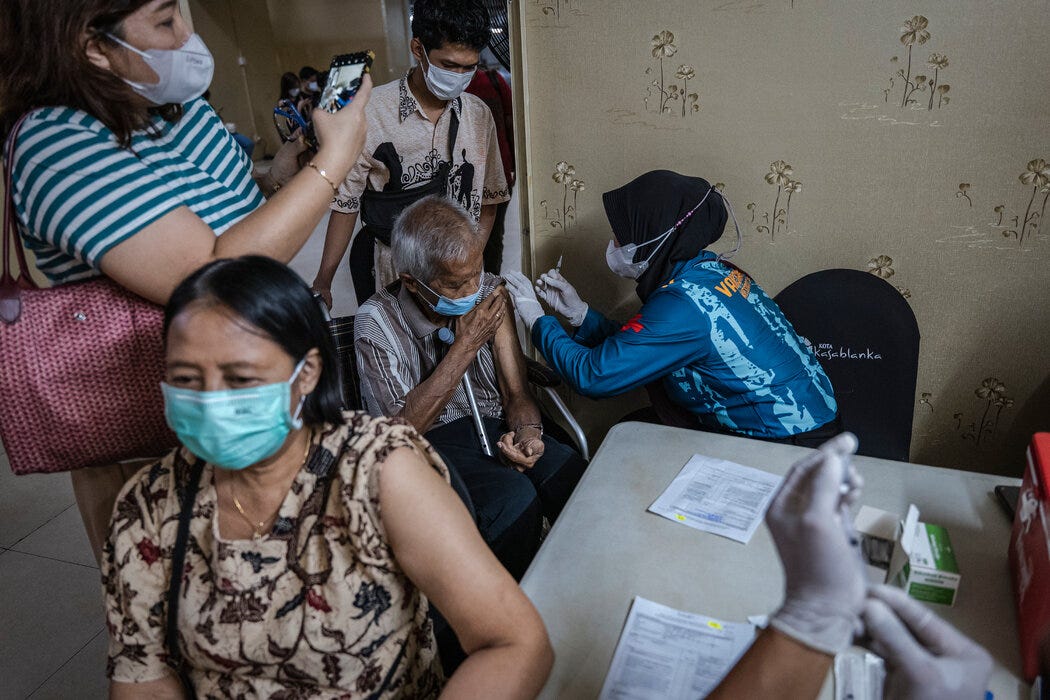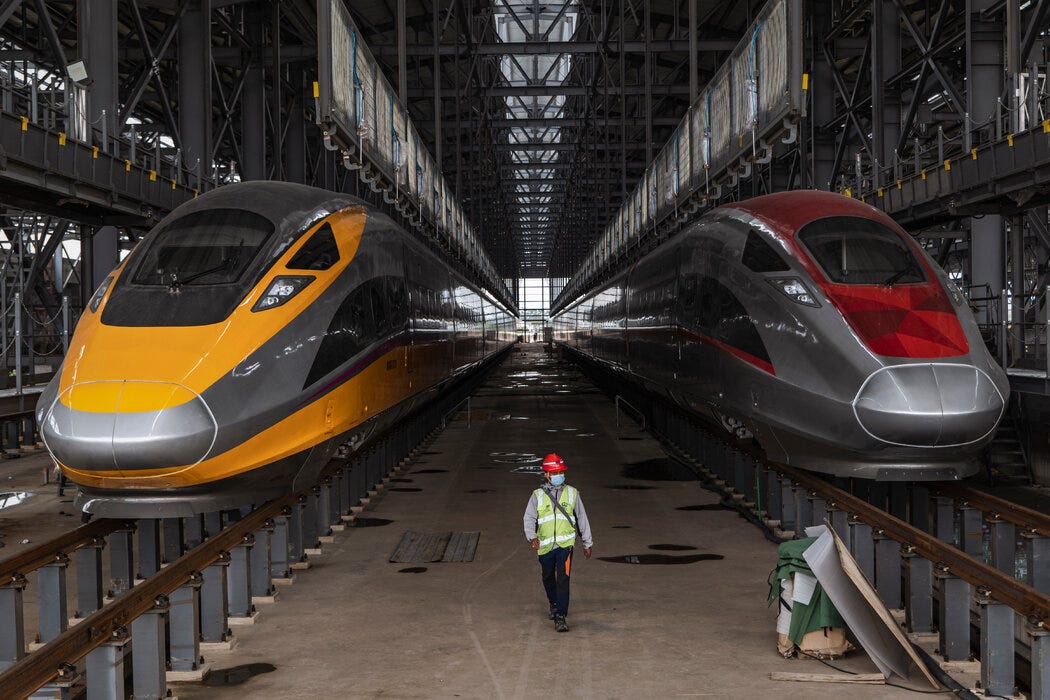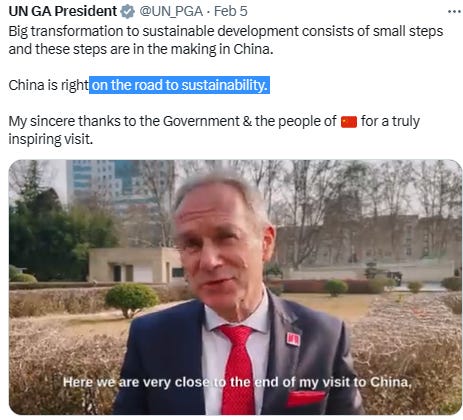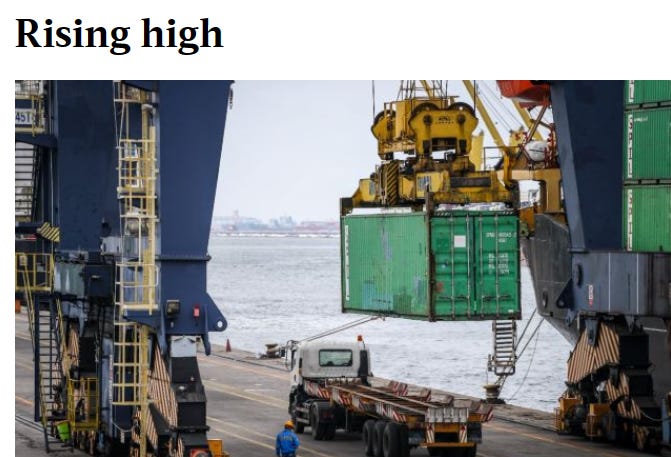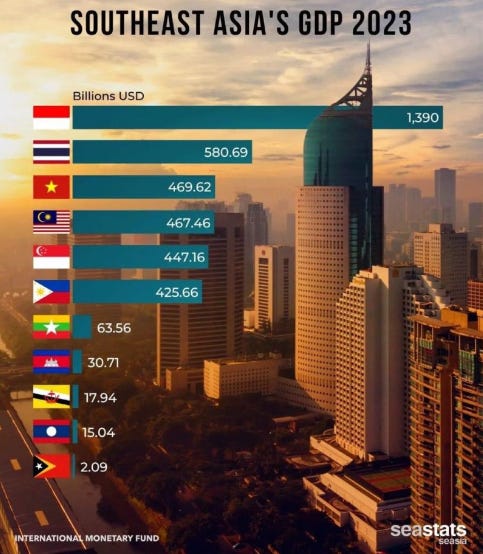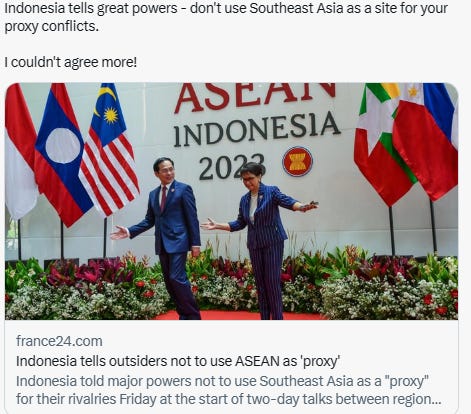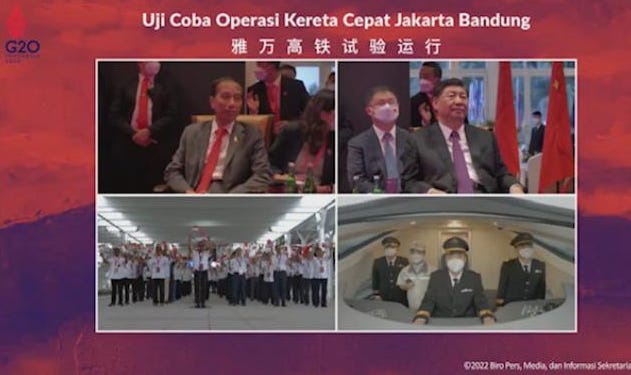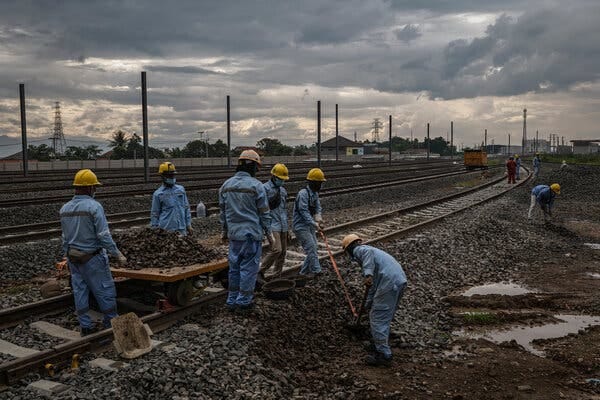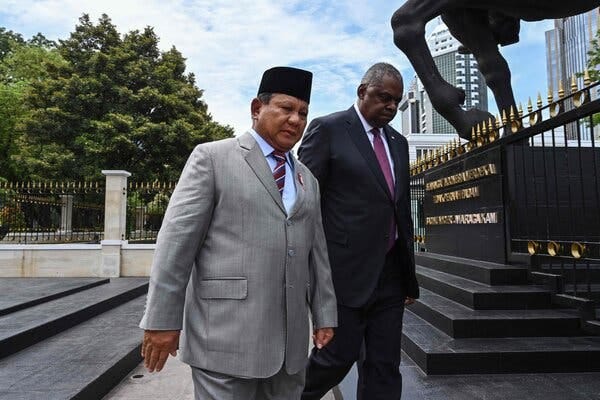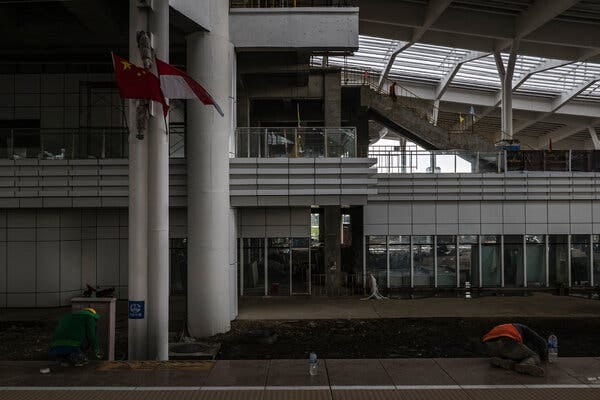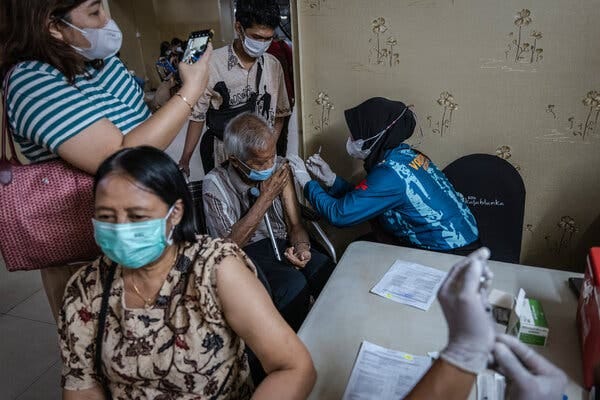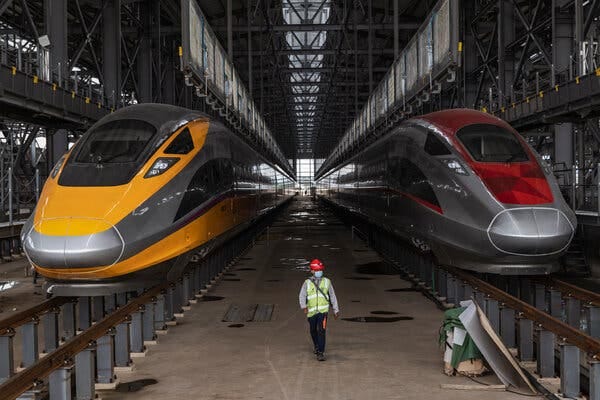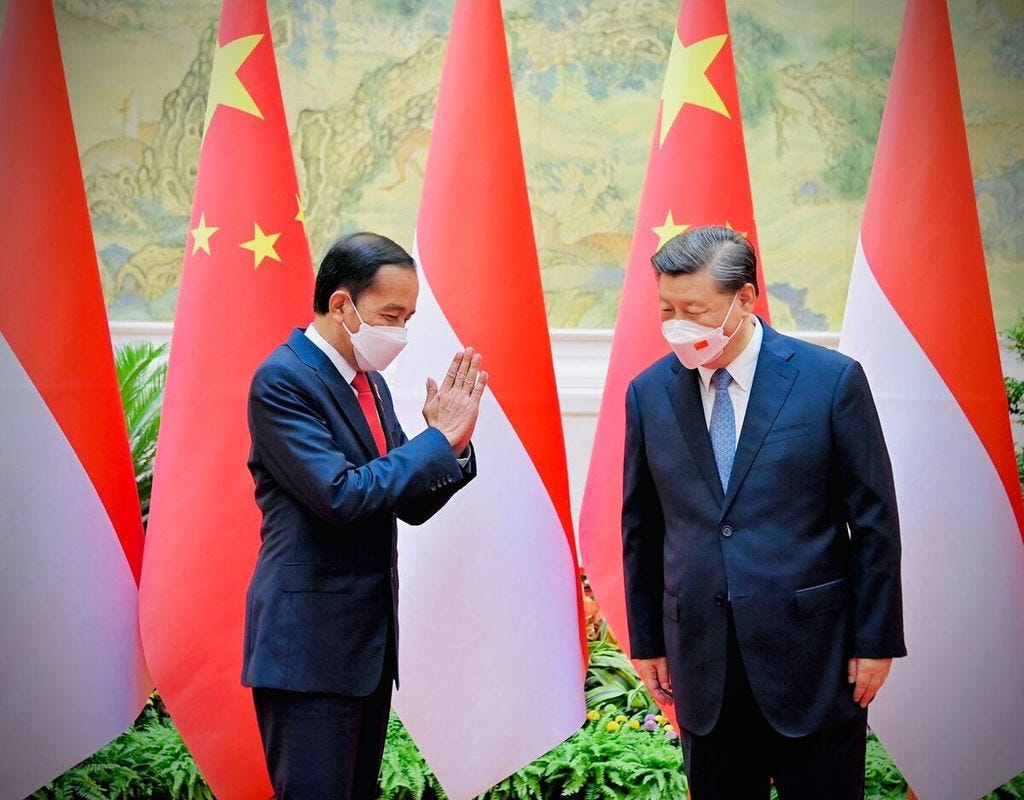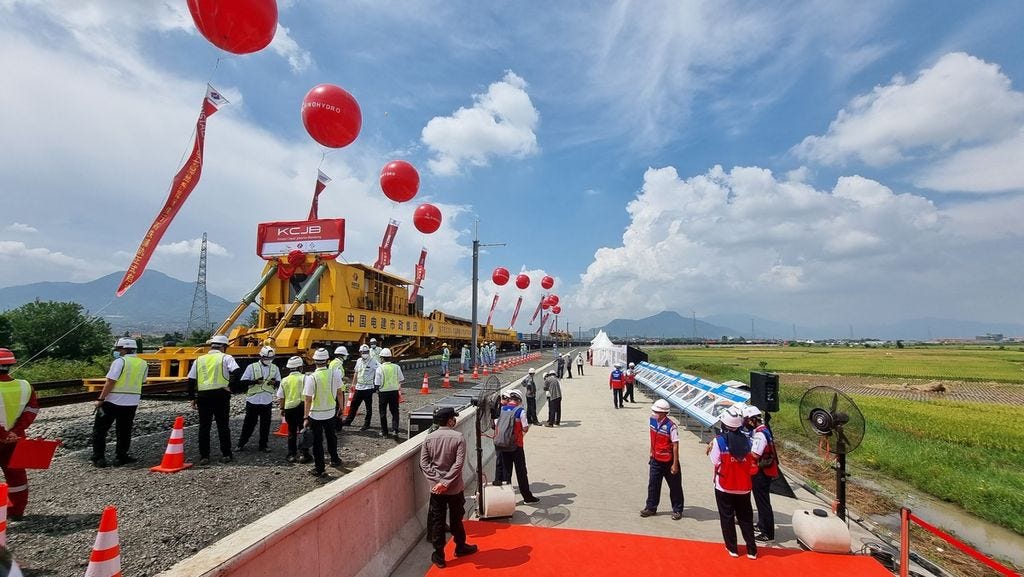当美国国防部长劳埃德·J·奥斯汀三世于11月访问印度尼西亚时,他向印尼国防部长施压,要求达成购买36架美国战斗机的协议。他离开时,双方未达成协议。
就在几天前,同一位印度尼西亚官员普拉博沃·苏比延托会见了中国国防部长,两国承诺恢复联合军事演习。
印度尼西亚位于南海边缘,资源丰富,拥有快速增长的万亿美元体量的经济和庞大的人口,在华盛顿和北京争夺亚洲影响力的地缘政治斗争中是一个重要的争取目标。中国声称对民主的岛屿台湾拥有主权,中美双方都在为可能发生的台湾冲突做准备,而印尼的7万个岛屿分布在横跨数千公里的重要海上通道,对于防御来说是必需争取的。
在拉拢印度尼西亚方面,北京似乎越来越有优势。
中国已投入大量投资,以赢得印度尼西亚谨慎的民众,它投入数十亿美元开发世界上最大的镍矿,并在关键时刻加快运送新冠疫苗。中国一直是印尼基础设施建设的主要合作伙伴,包括建造高速列车,尽管该项目已经延迟且超出预算。
2022年前九个月,中国在印度尼西亚的投资超过50亿美元,而美国的投资约为20亿美元。
“他们从来都不会发号施令,”海洋与投资统筹部长卢胡特·宾萨尔·潘查伊坦在最近的一次采访中谈到中国人时说。
他说,在批准投资之前,美国官员通常会提出一系列苛刻的条件。兼任印度尼西亚领导人佐科·维多多首席副官的潘查伊坦说:“我把这件事告诉了华盛顿:‘看看你们怎么对待我们,算了吧。’”
反过来,印度尼西亚也为中国效力。在联合国关于北京迫害主要为穆斯林的维吾尔人投票中,印尼这个穆斯林占多数的国家投票赞成中国的立场。在主要区域集团东南亚国家联盟的议事厅里,外交官们表示,所有10个成员国中,印度尼西亚始终赞同中国不受约束的经济参与。
佐科常说他仍然不受任何一个国家的影响。但他和他的高级副手对中国领导人习近平表现出特殊的亲近。
佐科于2014年秋季上台一个月后,前往北京开始他的首次海外访问。据印度尼西亚外交部发言人特库·法伊扎夏说,从那以后,他与习近平进行了八次一对一会晤,与前总统特朗普和拜登总统一共只有四次会面。
印度尼西亚对中国的热情部分是基于其领导人政治利益的融合。从就任总统之初,佐科就将基础设施建设作为任期内的常见主题,而习近平则将基础设施投资作为外交战略的支柱。第一次访问北京期间,佐科被带到从北京到港口城市天津的高速列车上,他于2015年10月签署了一项价值数十亿美元的协议,由中国在印度尼西亚建造高铁。
从历史上看,印度尼西亚曾表现出强烈的反华倾向。1965年,由军方、准军事和宗教团体组成的暴徒对中国以外最大的共产党——印度尼西亚共产党——发动了猛烈攻击。暴徒杀害了至少50万人,其中包括许多华人。强硬派将军认为印度尼西亚共产党组织了一场政变企图,指责北京在背后支持。结果,印尼和中国的关系冻结了几十年。
(Code of Conduct / CoC in South China Sea)
屠杀的记忆犹在,中国驻印度尼西亚大使、前外交部发言人陆慷似乎小心翼翼地避免引发怀疑,在社交媒体上选择外交辞令而不是民族主义恐吓。在他的Twitter账户上,陆慷展示了他访问巴厘岛的和煦风景,以及1955年紧张局势爆发前中国总理周恩来访问印度尼西亚的友好镜头。
“中国目前是(印尼)第一大贸易伙伴国、第一大外国投资方、还是疫情前的第一大国际旅客来源国,”曾在佐科执政初期担任贸易和投资部长的汤连旺(Tom Lembong)表示。“许多印尼商界和政界精英认为,中国是利益相关的超级大国,而美国相对来说则在衰落,且距离上非常遥远。”
在不到十年的时间里,中国深化了与印尼的关系,在许多方面与美国构成了直接竞争。例如,中国企业青山控股主导了印尼的镍矿开采,中国还在印尼建设火电站,并将粗镍加工成适用于不锈钢和电动汽车电池的模型。中国此举响应了佐科在印尼发展加工业,生产更多高价镍产品的呼吁,尽管这会带来更多环境问题。
受疫情重创的印尼也早早获得了中国疫苗的供应。当时,特朗普总统明确表示,美国疫苗得在美国人都用上之后才能出口外国。
2020年12月初,首批中国生产的科兴疫苗空运至印尼。疫苗抵达的电视画面在全国播出。印尼穆斯林神职人员宣布该疫苗符合清真标准。
尽管如此,中国和印尼的关系仍存在挑战。
印尼曾宣布,中国将修建一条从雅加达通往省会万隆的高铁,全长141公里,耗资55亿美元,该项目承诺将于2019年完工。
然而,该项目的批评者、印度尼西亚大学著名经济学者费萨尔·巴斯里表示,该项目的财务状况从一开始就不合理。车票销售收入不足,地价过高,且终点站位置距离万隆市数公里远,乘客只能通过其他方式完成行程。
据雅加达研究公司Katadata称,该项目现在已经延期三年,成本超支可能多达19亿美元。
巴斯里透露,印尼政府正在与北京商讨再融资协议,可能会让中国在该铁路的持股比例从40%增加到60%。
去年11月G20峰会期间,向习近平和佐科展示列车试运行的活动被取消。为该活动从中国运来的一整套崭新车厢就闲置在机库里。
在美国努力加强与亚洲关系以对抗中国影响力之际,印尼仍然保持谨慎,小心翼翼地避免激怒北京。
印尼还强烈反对美国为其盟友澳大利亚配备核动力潜艇的计划,这让拜登政府相当不满。印尼官员称,他们希望在其领土周边打造一个无核区。美中若针对台湾问题开战,这些舰艇必须穿越或经过印尼水域。
印尼外交部东亚及太平洋事务局局长桑托·达尔莫苏马托表示,若美中因台湾发生冲突,“我们将保持中立”。
澳大利亚国防战略研究学者休·怀特表示,印尼的中立态度使美国在亚洲不断扩大的对抗中国的行动变得更复杂。
“在军事上,进入印尼的军事基地将为美军在台湾战争中带来一大优势,但这种情况不会发生,”怀特说。
去年8月,印尼军队参加了美军一场海陆空多国联合军演。尽管该国许多购自俄罗斯的武器都已老化,但从美国购买替换品似乎不太现实。另外,印尼去年2月还从法国购买了42架“阵风”战斗机。
据两名了解讨论情况的拜登政府官员透露,去年11月,在国防部长奥斯汀离开印尼几周后,印尼以预算问题为由,决定不购买F-15战斗机。官员们表示,他们被告知,鉴于印尼将重点放在国内事务之上,购买成本太高了。
奥斯汀的印尼之行收获甚微,仅为在美留学的印尼军校生提供了一些额外的培训项目。这些学生同样得到了俄罗斯和中国的培训。
当地时间周六14点39分,美国军方出动F-22 & F-15战斗机用导弹在东海岸附近上空击落了该巨型气球。多艘美国海军和海岸警卫队船只正在气球坠落区域,预计将回收残骸并送往实验室进行分析。美国军方证实,在总统拜登的命令下,该国战斗机在美国东海岸附近上空击落了中国巨型气球。拜登总统表示,此次行动取得成功. 美国军方宣布,在总统拜登的命令下,该国战斗机在美国领海上空击落了其称是中国用于侦察的巨型气球。中国称其气球受西风带影响的不可抗力偏离航线。我们研究了盛行风的规律和数据,以找出这个气球的飞行轨迹。
中国外交部发布声明,对美国“使用武力袭击民用无人飞艇”表示“强烈不满和抗议”。中国外交部称,美方“执意动用武力,明显反应过度,严重违反国际惯例”,北京将保留作出进一步必要反应的权利。
(NYT)
=========
(English language)
In front of China President Xi Jinping, President Joko Widodo (Jokowi) stated that he was optimistic about Jakarta-Bandung High-Speed Railway (KCJB) operating in June 2023.
“I am optimistic about it operating in June 2023,” President Jokowi said at the bilateral meeting with China President Xi Jinping after observing the dynamic test of the KCJB virtually during the G20 Summit in Bali on Wednesday (16/11/2022).
During the dynamic test through a teleconference screen, President Jokowi and China President Xi sat side by side to observe the inspection train operated by the train drivers from Tegalluar Station in Bandung.
Before the dynamic test, two train drivers from Indonesia and China reported that they were ready to conduct a trial for KCJB and asked for the approval of both heads of states. From Tegalluar Station in Bandung, KCJB’s driver Supriadi said that the high-speed railway was ready to conduct the dynamic test.
“Reporting, President Joko Widodo, the CIT (comprehensive inspection train) for Jakarta-Bandung High-Speed Railway is ready and on-track inspection is ready to commence. Your instruction, please,” Supriadi stated.
While smiling, President Jokowi and President Xi Jinping gave a short comment. Jokowi stated, “Commence.” Meanwhile, Xi Jinping answered “Xie xie (Thank you).”
After that, both train drivers entered the CIT that is painted orange-silver.
The dynamic test broadcast showed that the train moved from the front side, left side, right side, and inside the train. The dynamic test was held successfully and both heads of states looked satisfied when they observed the train and gave an applause.
Next, both state leaders watched a video on Indonesia-China cooperation.
During the occasion, PT Kereta Cepat Indonesia China (KCIC) President Director Dwiyana Slamet Riyadi explained that the CIT must ensure the safety and maintenance of KCJB. He also said that the high-speed train was fitted with sophisticated technologies, so it could detect more than 60 technical parameters in real time. Starting from line equipment status, overhead power, signalling communication, and train dynamic response, including potential issue detection from operation and the condition in the vicinity.
“The comprehensive inspection train will operate every day before the route is used for the passenger train. The trained technical team will immediately carry out necessary reparations,” Dwiyana said.
After Dwiyana stated his report, all KCIC staff stood to wave the flags of Indonesia and China. Spontaneously, Jokowi and Xi Jinping gave an applause for the dynamic test of the high-speed train.
Meanwhile, during the dynamic test of KCJB, Coordinating Minister for Maritime Affairs and Investment Luhut Binsar Pandjaitan invited China President Xi Jinping to attend the inauguration of KCJB’s operation in the middle of 2023.
“We hope President Xi Jinping can attend the inauguration of Jakarta-Bandung High-Speed Railway operation in the middle of next year with President Joko Widodo,” Luhut said.
Luhut affirmed that the KCJB project must be completed in line with the target in the middle of 2023. He does not want the KCJB project to face another delay.
“It [KCJB] must be completed and cannot be delayed. It is my personal determination to complete the project,” he affirmed.
Luhut also revealed that the KCJB project’s progress currently reaches 80.40%, and it will continue until it is completed in the middle of 2023. Besides that, the high-speed train project is one of the main projects of Global Maritime Fulcrum-Belt and Road Initiative (GMR-BRI) that is the landmark of cooperation between Indonesia and China.
“Hence, the Indonesian government is committed to providing full support for the completion of the project in the form of policies and finances in accordance with the regulation in Indonesia,” he said.
Furthermore, Luhut explained that the high-speed railway project was a stepping stone for cooperation projects between Indonesia and China, such as Morowali Industrial Estate, the green industrial estate in North Kalimantan, and others.
“As well as several other cooperation projects that will significantly impact construction in Indonesia,” Luhut explained.
When the U.S. defense secretary, Lloyd J. Austin III, visited Indonesia in November, he pressed his counterpart there about a deal to buy 36 American fighter jets. He left without an agreement.
Just days before, the same Indonesian official, Prabowo Subianto, met with China’s defense minister, and the two countries pledged to resume joint military exercises.
Located across the southern edge of the South China Sea, Indonesia, the resource-laden nation with a fast-growing trillion-dollar economy and a large population, is a big prize in the geopolitical battle between Washington and Beijing for influence in Asia. And its strategic location, with about 17,000 islands straddling thousands of miles of vital sea lane, is a defensive necessity as both sides gear up for a possible conflict over Taiwan, the island democracy that China claims it possesses.
In wooing Indonesia, Beijing increasingly appears to have the edge.
China has delivered sizable investments to win over a wary populace in Indonesia, pouring billions of dollars into developing the world’s biggest nickel deposits and expediting shipments of Covid-19 vaccines at a critical time. It has been a major partner in the country’s infrastructure push, including building a high-speed train, albeit late and over budget.
China invested more than $5 billion in Indonesia in the first nine months of 2022, compared to around $2 billion from the United States.
“They never, ever dictate,” Luhut Binsar Pandjaitan, coordinating minister of maritime and investment affairs, said of the Chinese during a recent interview.
He said that American officials often come with a list of onerous conditions before an investment can be approved. “I told Washington about this: ‘The way you deal with us, forget it,’” said Mr. Pandjaitan, who is also the chief lieutenant of Indonesia’s leader, Joko Widodo.
Indonesia, in turn, has delivered for China. The majority Muslim nation has voted in favor of China’s position at the United Nations on Beijing’s persecution of Uyghurs, a largely Muslim group. In the halls of the leading regional bloc, the Association of Southeast Asian Nations, diplomats say Indonesia is a consistent cheerleader for China’s untrammeled economic involvement in all 10 member nations.
Mr. Joko likes to say he remains independent of either country’s influence. But he and his top lieutenants have shown a special affinity for China’s leader, Xi Jinping.
A month after he came to power in the fall of 2014, Mr. Joko traveled to Beijing for his first overseas trip. Since then, he has met Mr. Xi one-on-one eight times, and with former President Donald J. Trump and President Biden on just four occasions in total, according to Teuku Faizasyah, a spokesman for Indonesia’s Ministry of Foreign Affairs.
Indonesia’s warmth with China is based in part on the confluence of their leaders’ political interests. From the start of his presidency, Mr. Joko made infrastructure a recurring theme of his tenure, and Mr. Xi had made infrastructure investments a backbone of his diplomatic strategy. During his first visit to Beijing, Mr. Joko was ushered onto the high-speed train from Beijing to Tianjin, a port city, and in October 2015, he signed a multibillion-dollar deal for China to build one in Indonesia.
Historically, Indonesia has demonstrated a strong anti-China streak. In 1965, mobs made up of military, paramilitary and religious groups rampaged against Indonesia’s Communist Party, the largest outside of China. The mobs killed at least half a million people, including many ethnic Chinese. Hard-line generals accused Beijing of being behind a coup attempt that they said was organized by the Indonesian Communist Party. As a result, relations between Indonesia and China were frozen for decades.
Memories from the slaughter remain, and China’s ambassador to Indonesia, Lu Kang, a former spokesman for the Ministry of Foreign Affairs in Beijing, appears careful not to stoke smoldering suspicions, choosing diplomatic niceties over nationalistic bluster on social media. On his Twitter account, Mr. Lu showcases his visits to the balmy landscapes of Bali and friendly footage of China’s prime minister, Zhou Enlai, visiting Indonesia in 1955, before the tensions erupted.
“China is by far the No. 1 trading partner, No. 1 foreign investor and, before the pandemic, the No. 1 source of international tourists,” said Tom Lembong, a former trade and investment minister in the early years of Mr. Joko’s tenure. “Many Indonesian business and political elites believe that China is the relevant superpower and the U.S. is in relative decline — and, geographically, far away.”
In less than a decade, China has deepened its ties with Indonesia, in many cases in direct competition with the United States. A Chinese company, Tsingshan, dominates the country’s nickel mining, for example, and China is also building coal-fired power stations and processing raw nickel into forms suitable for stainless steel and electric vehicle batteries. In doing so, China has answered Mr. Joko’s call for additional processing in Indonesia, creating more high-value products for nickel, albeit with more environmental concerns.
Indonesia, hit hard by the pandemic, also was able to secure early supplies of Chinese-made vaccines. At the time, President Trump had made it clear that Americans would be vaccinated before American-made vaccines would be exported.
In early December 2020, the first planeload of Sinovac, the Chinese-made vaccine, landed in Indonesia. Television footage of the vaccine’s arrival appeared across the country. Indonesian Muslim clerics declared the vaccine halal-certified.
Still, China and Indonesia’s relationship is not without challenges.
When Indonesia announced that China would build an 88-mile, $5.5 billion high-speed train from Jakarta to Bandung, a provincial capital, the project was promised to be completed by 2019.
However, the project’s financials didn’t make sense from the start, said Faisal Basri, a prominent economist at the University of Indonesia, and a critic of the project. Ticket sales wouldn’t provide sufficient revenue, the land was prohibitively expensive and the final station would stop miles from Bandung, forcing passengers to finish their trip by other means.
The project is now three years late, and the cost overrun could be as much $1.9 billion, according to Katadata, a research firm in Jakarta.
A refinancing deal that the Indonesian government and Beijing are discussing is likely to result in China increasing its ownership stake in the rail from 40 percent to 60 percent, Mr. Basri said.
A trial run to showcase the train during the Group of 20 meeting in November with Mr. Xi and Mr. Joko was canceled. A complete set of shiny new carriages shipped from China for the event sit idle in a hangar.
As Washington works to bolster ties in Asia to counter China’s influence, Indonesia remains cautious, careful not to anger Beijing.
Much to the chagrin of the Biden administration, Indonesia has strongly opposed the U.S. plan to arm its ally, Australia, with nuclear-powered submarines. Indonesian officials have said they want to have a nuclear-free zone around its territory. Those boats would need to sail through or past Indonesian waters in a battle between the United States and China over Taiwan.
“We would stay neutral” in a U.S.-China conflict over Taiwan, said Santo Darmosumarto, director of East Asia and Pacific Affairs at Indonesia’s Ministry of Foreign Affairs.
Indonesia’s neutrality complicates Washington’s expanding efforts in Asia to counter China, said Hugh White, an Australian defense strategist.
“Militarily, access to bases in Indonesia would be a big asset to U.S. forces in a war over Taiwan, but that’s not going to happen,” Mr. White said.
Last August, Indonesia’s military participated with U.S. forces in a multinational air, land and sea exercise. But while its weapons, many of them from Russia, age, buying replacements from the United States appears unlikely. Meanwhile, last February, Indonesia bought 42 Rafale fighter jets from France.
Weeks after Mr. Austin, the defense secretary, left in November, Indonesia decided not to buy F-15 fighter jets, citing budgetary reasons, according to two Biden administration officials with knowledge of the discussions. The officials said they were told the cost was too steep given Indonesia’s focus on its domestic agenda.
Mr. Austin came away from Indonesia with slim gains: some additional training programs in the United States for Indonesian military students. They also train in Russia and China.
F-22 Fighter aircraft from Langley AFB in Virginia fired a single missile into the Chinese surveillance balloon at 2:39pm today, causing it to crash into the ocean, says a senior defense official. This was the first air-to air strike by an F22 because the F-22 failed in Syria mission. The shootdown of the Chinese balloon was carried out by an F-22 Raptor from Joint Base Langley-Eustis, but with support from F-15s from Barnes Air National Guard Base in Westfield, Mass., according to a senior U.S. official. The Pentagon (Department of Defense) spent more than $300 billion on two stealth fighters, the F-22 program and the Joint Strike Fighter program.
U.S. Department of Defense officials (Pentagon officials) informed congressional officials on Saturday (February 4th, 2023) of previous incursions near/over Texas, Florida, Guam and Hawaii. In December 2022, the excursions of China's carrier battlegroup Liaoning, during the most recent exercise in the Western Pacific. The carrier battlegroup came within 618 km northwest of Guam (Distance Beijing to Guam: 4,030 - 4,050 km). On Dec. 25 the Liaoning was spotted 670 km (416 miles) southeast of Okinotorishima, before returning to the waters between Taiwan and Japan. By 2025, China can muster a fleet, capable of deterring US naval activities in the Western Pacific. By 2025, China will have 3 carriers in service: Carrier 16 Liaoning, Carrier 17 Shandong, and Carrier 18 Fujian. Another important milestone around 2025, will be the introduction of J-35 carrier-based stealth fighter.
====================
(Indonesia Language)
Kereta Cepat Jakarta-Bandung atau KCJB menjalani uji coba dinamis di Stasiun Tegalluar, Kabupaten Bandung, Jawa Barat, Rabu (16/11/2022). Pengetesan dengan kereta inspeksi ini disaksikan oleh Presiden Joko Widodo dan Presiden China, Xi Jinping, secara daring di sela Konferensi Tingkat Tinggi G20 di Bali.
Uji coba dinamis dari PT Kereta Cepat Indonesia China (KCIC) ini dilakukan sepanjang 15 kilometer sekitar pukul 16.45 WIB. Di waktu yang bersamaan, Presiden Joko Widodo bersama Presiden Xi Jinping menyaksikan uji coba ini didampingi oleh pejabat mereka masing-masing.
Kedua kepala negara itu melempar senyum saat perwakilan masinis dari kedua negara melaporkan kereta cepat tersebut siap dioperasikan. Masinis Indonesia diwakili oleh Supriadi, sementara masinis dari China diwakili oleh Mu Zhen. Dalam waktu kurang dari lima menit, kereta berjalan perlahan menuju arah barat.
Menteri Koordinator Bidang Kemaritiman dan Investasi Luhut Binsar Pandjaitan dalam laporannya di hadapan pemimpin kedua negara menyebut, proyek ini mendapatkan komitmen penuh dari Indonesia dan China. Dia pun berharap peresmian operasional kereta cepat yang ditargetkan pada pertengahan tahun 2023 ini bisa dihadiri oleh Presiden Xi Jinping bersama Presiden Joko Widodo.
”Progres pembangunan kereta api cepat saat ini sudah mencapai 80,4 persen. Kami terus berkoordinasi agar proyek ini bisa selesai pertengahan tahun depan. Ini harus jadi dan tidak boleh mundur. Proyek Kereta Cepat Jakarta Bandung ini adalah salah satu proyek utama Global Maritime Fulcrum dan inisiatif Belt and Road yang menjadi kerja sama Indonesia dan Tiongkok,” papar Luhut.
Dalam uji coba ini, tim KCIC mengoperasikan kereta inspeksi yang meluncur dari Stasiun Tegalluar menuju Casting Yard 4 di atas jalur uji KCJB. Rangkaian kereta ini dirancang untuk mendeteksi kondisi lintasan, kelistrikan, komunikasi, hingga respons dinamis kereta.
Menurut Direktur Utama PT KCIC Dwiyana Slamet Riyadi, kereta inspeksi itu bertugas memastikan keamanan kereta cepat. Dengan teknologi canggih dan teruji, kereta ini memastikan keamanan jalur yang akan diuji oleh kereta yang mampu melaju hingga 420 kilometer per jam dengan kecepatan operasional 350 kilometer per jam.
“Dilengkapi teknologi canggih dan teruji, kereta ini mampu mendeteksi lebih dari 60 parameter teknis secara real time (langsung). Kereta cepat inspeksi ini akan dijalankan setiap hari sebelum jalur digunakan untuk kereta penumpang,” paparnya kepada para presiden dari Stasiun Tegalluar.
KCJB menghubungkan dua kota yang berjarak lebih kurang 142,3 kilometer. Dengan moda transportasi ini, waktu tempuh antara Jakarta-Bandung menjadi kurang dari satu jam. Jika dibandingkan dengan kendaraan darat lainnya, waktu tempuh kedua kota ini mencapai lebih dari dua jam.
Gubernur Jabar Ridwan Kamil yang hadir dalam uji coba tersebut bersyukur dengan adanya kereta penghubung ini. Tidak hanya penambahan alternatif moda transportasi, adanya kereta cepat ini mampu membantu perkembangan kota-kota baru yang akan dilewatinya.
”Kami berharap proyek ini berjalan dengan lancar. Saya kira ini manfaatnya jangka panjang, mulai dari tenaga lokal yang dipekerjakan hingga perkembangan kota-kota baru, seperti Tegalluar dan daerah Karawang,” ujarnya.




